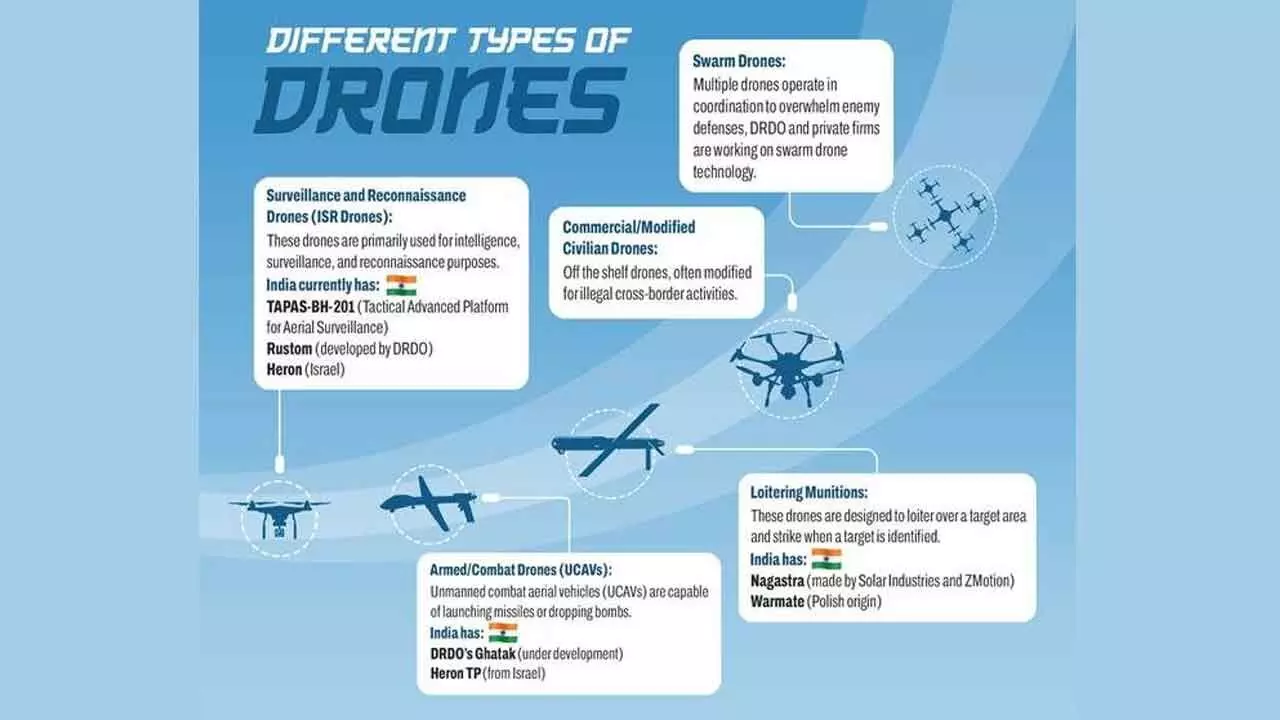Tech As First Line Of Protection
The integration of drone warfare into India’s military doctrine owes its success to years of domestic R&D and policy reform
Tech As First Line Of Protection

Operation SINDOOR emerged as a calibrated military response to an evolving pattern of asymmetric warfare, one that increasingly targets unarmed civilians along with military personnel. The terrorist attack on tourists in Pahalgam in April 2025 served as grim reminder of this shift. India’s response was deliberate, precise, and strategic. Without crossing the Line of Control or international boundary, Indian forces struck terrorist infrastructure and eliminated multiple threats. However, beyond tactical brilliance, what stood out was the seamless integration of indigenous hi-tech systems into national defence. Whether in drone warfare, layered air defence, or electronic warfare, Operation SINDOOR marks a milestone in India’s journey towards technological self-reliance in military operations.
On the night of 07-08 May 2025, Pakistan attempted to engage a number of military targets in Northern and Western India including Awantipura, Srinagar, Jammu, Pathankot, Amritsar, Kapurthala, Jalandhar, Ludhiana, Adampur, Bhatinda, Chandigarh, Nal, Phalodi, Uttarlai, and Bhuj, using drones and missiles. These were neutralised by the Integrated Counter UAS (Unmanned Aerial Systems) Grid and Air Defence systems. Air Defence systems detect, track, and neutralise threats using a network of radars, control centres, artillery, and both aircraft- and ground-based missiles. On the morning of May 8, the Indian Armed Forces targeted Air Defence Radars and systems at a number of locations in Pakistan. An Air Defence system at Lahore was neutralised.
As part of Operation SINDOOR, the following were used: Battle-proven AD (Air Defence) systems like the Pechora, OSA-AK and LLAD guns (Low-level air defence guns); and, indigenous systems such as the Akash, which demonstrated stellar performance
Neutralized threats
Operation SINDOOR also produced concrete evidence of hostile technologies neutralized by Indian systems: Pieces of PL-15 missiles (of Chinese origin); Turkish-origin UAVs, named "Yiha" or "YEEHAW"; Long-range rockets, quadcopters and commercial drones. These were recovered and identified, showing that despite Pakistan's attempts to exploit advanced foreign-supplied weaponry, India’s indigenous air defence and electronic warfare networks remained superior.
Drone power
The Drone Federation India (DFI), is a premier industry body representing over 550 drone companies and 5500 drone pilots[4]. DFI’s vision is to make India a global drone hub by 2030, and it promotes the design, development, manufacturing, adoption and export of Indian drone and counter-drone technology worldwide. DFI enables ease of doing business, promotes the adoption of drone technology, and hosts several programs like Bharat Drone Mahotsav.[5] Some companies involved in the drone space are: Tata Advanced Systems offers a full range of integrated solutions across Defence & Security and has served as a trusted partner to India's armed forces for over six decades. Paras Defence & Space Technologies operates within the Defence and Space segments, distinguished by Indigenously Designed Developed and Manufactured (IDDM) capabilities. IG Drones is a Drone Technology Company for manufacturing and R & D of Drones specialized in defence and other industry applications along with provider of drone related services like drone surveying, mapping & inspection by industry experts. The company has partnered with Indian Army, Government of India , multiple State Governments, among others. The integration of drone warfare into India’s military doctrine owes its success to years of domestic R&D and policy reform.
Meanwhile, defence exports crossed the record figure of about Rs 24,000 crore in Financial Year 2024-25. The aim is to increase the figure to Rs 50,000 crore by 2029, and make India a developed nation and the world's largest defence exporter by 2047.
India has emerged as a major defence manufacturing hub, driven by the “Make in India” initiative and a strong push for self-reliance. In FY 2023–24, indigenous defence production reached a record Rs 1.27 lakh crore, while exports soared to Rs 23,622 crore in FY 2024–25, a 34-fold increase from 2013–14. Strategic reforms, private sector involvement, and robust R&D have led to the development of advanced military platforms like the Dhanush Artillery Gun System, Advanced Towed Artillery Gun System (ATAGS), Main Battle Tank (MBT) Arjun, Light Specialist Vehicles, High Mobility Vehicles, Light Combat Aircraft (LCA) Tejas, Advanced Light Helicopter (ALH), Light Utility Helicopter (LUH), Akash Missile System, Weapon Locating Radar, 3D Tactical Control Radar, and Software Defined Radio (SDR), as well as naval assets like destroyers, indigenous aircraft carriers, submarines, frigates, corvettes, fast patrol vessels, fast attack craft, and offshore patrol vessels.
Operation SINDOOR is not just a story of tactical success. It is a validation of India’s defence indigenization policies. From air defence systems to drones, from counter-UAS capabilities to net-centric warfare platforms, indigenous technology has delivered when it mattered most. The fusion of private-sector innovation, public-sector execution, and military vision has enabled India to not only defend its people and territory but also assert its role as a hi-tech military power in the 21st century. In future conflicts, the battlefield will increasingly be shaped by technology. And India, as shown in Operation SINDOOR, is ready, armed with its own innovations, backed by a determined state, and powered by the ingenuity of its people. (PIB)

